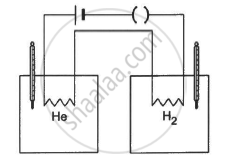Advertisements
Advertisements
प्रश्न
4.0 g of helium occupies 22400 cm3 at STP. The specific heat capacity of helium at constant pressure is 5.0 cal K−1 mol−1. Calculate the speed of sound in helium at STP.
उत्तर
Given:
Specific heat capacity at constant pressure, Cp = 5.0 cal/mol-K
Cp = 5.0 × 4.2 J/mol-K
Cp = 21 J/mol-K
Volume of helium, V = 22400 cm3 = 0.0224 m3
At STP, P = 1 atm = 105 Pa
The speed of sound in gas,
`"v" = sqrt((gamma"p")/ρ) =sqrt((gamma "R" "T")/"M") = sqrt ( (gamma "P""V")/"M")`
`"C"_"p" = ("R"gamma)/(gamma -1)`
Or 21(γ − 1) = 8.3γ
⇒ 21γ − 8.3γ = 21
⇒ 12.7γ = 21
`therefore gamma = 21/12.7 = 1.653``"v" = sqrt ((1.653 xx 1.0 xx 10^5 xx 0.0224)/ (4 xx 10 ^-3))`
v = 960 m/s
APPEARS IN
संबंधित प्रश्न
A metre long narrow bore held horizontally (and closed at one end) contains a 76 cm long mercury thread, which traps a 15 cm column of air. What happens if the tube is held vertically with the open end at the bottom?
The specific heat capacity of water is
Can we define specific heat capacity at constant temperature?
Does a solid also have two kinds of molar heat capacities Cp and Cv? If yes, is Cp > Cv? Or is Cp − Cv = R?
Can a process on an ideal gas be both adiabatic and isothermal?
Show that the slope of the p−V diagram is greater for an adiabatic process compared to an isothermal process.
Two samples A and B are initially kept in the same state. Sample A is expanded through an adiabatic process and the sample B through an isothermal process. The final volumes of the samples are the same. The final pressures in A and B are pA and pBrespectively.
Let ∆Wa and ∆Wb be the work done by the systems A and B, respectively, in the previous question.
Consider the processes A and B shown in the figure. It is possible that

Three identical adiabatic containers A, B and C contain helium, neon and oxygen, respectively, at equal pressure. The gases are pushed to half their original volumes.
(a) The final temperatures in the three containers will be the same.
(b) The final pressures in the three containers will be the same.
(c) The pressures of helium and neon will be the same but that of oxygen will be different.
(d) The temperatures of helium and neon will be the same but that of oxygen will be different.
A sample of air weighing 1.18 g occupies 1.0 × 103 cm3 when kept at 300 K and 1.0 × 105 Pa. When 2.0 cal of heat is added to it at constant volume, its temperature increases by 1°C. Calculate the amount of heat needed to increase the temperature of air by 1°C at constant pressure if the mechanical equivalent of heat is 4.2 × 107 erg cal−1. Assume that air behaves as an ideal gas.
An ideal gas expands from 100 cm3 to 200 cm3 at a constant pressure of 2.0 × 105 Pa when 50 J of heat is supplied to it. Calculate (a) the change in internal energy of the gas (b) the number of moles in the gas if the initial temperature is 300 K (c) the molar heat capacity Cp at constant pressure and (d) the molar heat capacity Cv at constant volume.
Air (γ = 1.4) is pumped at 2 atm pressure in a motor tyre at 20°C. If the tyre suddenly bursts, what would be the temperature of the air coming out of the tyre? Neglect any mixing with the atmospheric air.
The figure shows two vessels with adiabatic walls, one containing 0.1 g of helium (γ = 1.67, M = 4 g mol−1) and the other containing some amount of hydrogen (γ = 1.4, M = 2 g mol−1). Initially, the temperatures of the two gases are equal. The gases are electrically heated for some time during which equal amounts of heat are given to the two gases. It is found that the temperatures rise through the same amount in the two vessels. Calculate the mass of hydrogen.

The speed of sound in hydrogen at 0°C is 1280 m s−1. The density of hydrogen at STP is 0.089 kg m−3. Calculate the molar heat capacities Cp and Cv of hydrogen.
If at same temperature and pressure, the densities for two diatomic gases are respectively d1 and d2 then the ratio of velocities of sound in these gases will be ______.
